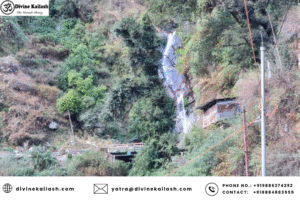Delve deep into the spirituality of the Yamunotri Temple
Yamunotri is a holy location surrounded by trees, greenery, and pure nature. It’s known for its famed glaciers and thermal springs. It is the first of Chota char Dham Yatra circuit destinations. This is the origins of the river Yamuna and goddess Yamuna’s abode. Yamunotri is cradled in Garhwal Himalayas in the Uttarkashi district of Uttarakhand, at a fluttering height of 3,293 meters. As history suggests, Asit Muni, a respected sage, lived here. The holy Yamuna River’s real origin is ice and snow lake on the Kalind Mountain is recognized as the Champasar Snow.
Take a sneak peek at the origin of the temple
As the true place of origin is remote and unapproachable, the temple is for devotees to give prayers at the foothill. Yamunotri Dham is one of India’s and perhaps the world’s most widely regarded dhams. As the name implies, from its position on the banks of the holy river Yamuna and the presiding deity of Goddess Yamuna, this Dham gets its name. People on a Char Dham Yatra pilgrimage begin their journey from Yamunotri dhams and then go on to their other destinations.
Yamunotri temple is believed to be the oldest and holiest shrines in India.
Encircled by unparalleled serene natural elegance and situated on top of a flank of the Bandarpoonch Parvat, this temple is considered one of India’s oldest and most holy shrines. Surrounding the temple is a variety of fascinating locations for an interested traveler to try and discover. One of the key attractions here is a natural hot water source used by the pilgrims to cook rice and potatoes, which is later served to the devotees as Prasadam. The temple is renowned for its picturesque charm, unique spiritual vibes. Yamunotri temple is a significant pilgrimage destination for any pious Hindu. The ‘significance’ of the Yamunotri temple can be criticized from various angles.
The temple comes with significance- let’s take a look
Significance from the spiritual purpose
The Temple of Yamunotri is an important pilgrimage site for every pious Hindu. You can assess the ‘symbolic importance’ of the Yamunotri temple from different angles. The devotees find Goddess Yamuna, to whom the Yamunotri temple is devoted, to be a divine mother goddess. Both Hindu devotees firmly assume that by attending the Yamunotri shrine, by praying at the feet of Goddess Yamuna, by having the opportunity to experience the sacred ‘Prasadam’ and by taking a sacred dip in the Yamuna River, they will be able to absolve both their mortal sins and heal from the most immense mortal terror, the ‘fear of death.’ Cooking ‘Prasadam’ from the water of nearby hot springs is a practice inside the temple. The hot spring-fuming water will quickly help to cook rice, pulses, and boil vegetables. So you can assume how hot the water is.
Significance from the architectural point
The Yamunotri temple was first built in 1839 AD at the initiative of the King of Garhwal, Tehri Naresh Sudarshan Shah, and it was constructed over the original ancient temple. But later, an earthquake caused significant damage to the temple, which was then repaired and reconstructed by Jaipur’s Maharani, Guleria. This was in the nineteenth century. But what we see today as the Yamunotri temple is the culmination of several repairs and architectural projects, under the patronage of the wealthy royal families.
Significance from the mythological point
Hindu mythology states that Yamuna Devi is the daughter of Sun God or Surya Dev, and her mother is Saranyu Devi, and her brother is the ‘Angel of Destruction’ Yama. Thus Yamuna Devi assumes considerable divine significance for Hindus due to the legendary facts linked to her conception and origin. Devotees claim they will also satisfy and thereby get blessed by Surya Dev, Yama, Sughna Devi by worshiping Yamuna Devi.
Do you know why the color of the river is black?
Yamunotri temple reflects the origins of the holy Yamuna water. The river’s real source is a frozen glacier called Champasar glacier, at an altitude of 4421 m. A Kund or Lake emerges from this area and is known as the Sapta Rishi Kund. Trekking to this location is incredibly challenging, but it’s worth a visit as this is the spot where the holy flower, ‘Brahma Kamal,’ blooms once a year in July – Aug. In Hindu Mythology, the flower has spiritual meaning. It is said that Lord Krishna represents the white stamen of the herb and that the 100 Kauravas are considered to be the reddish stalks. Lord Shiva is believed to have swapped Lord Ganesha’s head with an elephant’s head using Brahma Kamal.
There is a pervasive myth that the river’s color is black because it has engrossed Lord Shiva’s misery and sorrow since his wife Sati’s demise.
The benefits of revisiting the Yamunotri temple
- Yamunotri is one of Uttarakhand’s Chota Char Dham Temples loops.
- Some Puranas, such as Padma Purana, state that having a holy bath in the Yamuna River washes away an individual’s sins and grants Moksha or redemption.
- To cook a handful of rice and potatoes in muslin cloth at Surya Kund’s hot water sulfur bath. This is the rite, which is mandatory for all pilgrims.
- It is considered to be a “Prasadam” or gift intended as a spiritual cleanser.
Festivals that you can experience while visiting the Yamunotri temple
- Basant Panchami.
- Phool Dei.
- Olgia.
Basant Panchami, January – February:
- Worshippers offer the ‘puja’ to Goddess Saraswati during this festival.
- People wear yellow clothes during the day, adorn their foreheads with yellow-colored tilak made from turmeric paste.
- People use handkerchiefs crafted from yellow pieces of fabric.
Phool Dei, March:
- Devotees sell peers a bag or platter full of beans, vegetables, jaggery, and coconut.
- They also get blessed in turn with food, rice, sweets, and jaggery.
- On this day, Goddess Yamuna is given a rare savory called Sei.
Olgia, August:
- The day is characterized by unique ghee adornment on citizens’ foreheads and Dal Chappatis feeding with ghee.
- Nephews and sons-in-law are also given presents to maternal uncles and fathers-in-law respectively.





